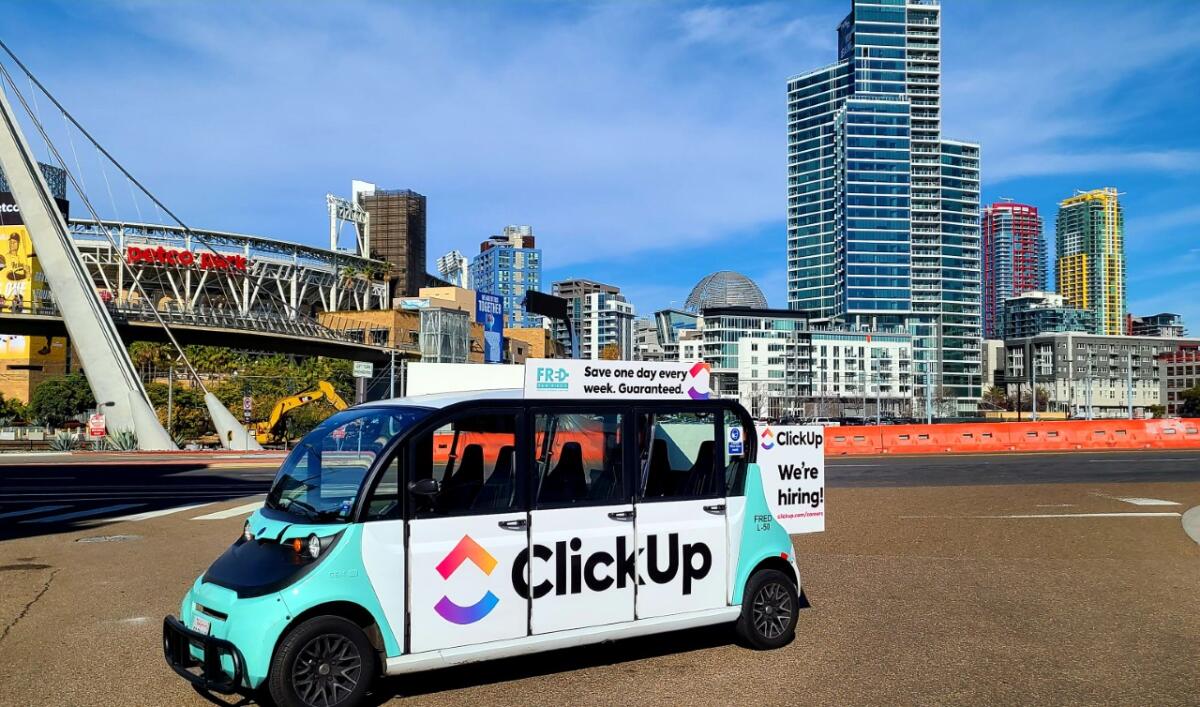
As neighborhoods densify, we should demand that cities provide neighborhood shuttle service to relieve increased traffic and parking pressure
BY SANJIV NANDA, CRAIG JONES, RITA CLEMENT
Commentary published in the San Diego Union Tribune on Dec 11, 2023
Nanda is a SanDiego350 microtransit expert and past executive strategic adviser with SANDAG and lives in Mira Mesa. Jones is a SanDiego350 expert on land use and a retired city of San Diego urban planner and lives in Scripps Ranch. Clement is SanDiego350 Transportation Team co-lead and lives in Chula Vista.
Cities around San Diego County are rolling out app-enabled neighborhood shuttle services. If you haven’t experienced a ride, you should check it out in various locations: Free Rides Everywhere Downtown or FRED in Downtown San Diego, Free Rides Around National City or FRANC in National City, gO’side Shuttle in Oceanside and the Beach Bug in Pacific Beach. In Chula Vista, there’s a Community Shuttle for those 55 and over.
Urban and semi-urban “mobility zones,” served by fleets of futuristic-looking electric shuttles able to carry five to 10 passengers, are a vision from the future that can serve your community today. Since most of us don’t live within a 10-minute walk of a trolley station or express bus stop, the neighborhood shuttle provides a convenient “last-mile” connection to countywide rapid transit. In addition, neighborhood shuttles can transport students to school and the local library, seniors to shopping and health care, and be a lifeline for zero- and one-car households. Microtransit is another term for these shared ride neighborhood shuttle services.
These services operate like a pooled Uber or Lyft: When you request a ride to a destination within the zone, the app gives you the pickup time and a location that may be a street corner a few minutes walk away from you. Instead of taking you directly to your destination, the ride may involve short detours to pick up/drop off others. Shared rides reduce both the cost per ride, as well as the number of vehicles on the road, thus reducing overall congestion and pollution.
With over 100 deployments across North America, private companies (notably Via Transportation, Ride Circuit and The Routing Company) have matured AI software that manages pickups, dropoffs and vehicle routing to maximize efficiency. Ride Circuit operates the examples listed above.
California cities face growing shortfalls of affordable housing with access to transit. Senate Bill 9 (2021) promotes infill development by permitting a homeowner to subdivide and construct up to four units on a lot. Local jurisdictions streamlined the permitting and approval process for accessory dwelling units (ADUs). Unless served by transit, increased infill development leads to more neighborhood traffic and congestion. Homeowners are legitimately concerned about parking with additional density. Here, neighborhood shuttles come to the rescue, as local and last-mile trips can be completed without a personal vehicle, allowing families to have one less car for the household. As neighborhoods densify, we should demand that cities provide neighborhood shuttle service to relieve increased traffic and parking pressure.
In February 2023, San Diego adopted a new Sustainable Development Area definition to allow incentives if housing developments are accessible to major public transit stops within a 1-mile walk. Previously, transit-oriented incentives were only available up to a mile radius from transit. Per the city of San Diego, this increases the potential developable areas by more than 5,200 acres.
We are informed that when the City Council debated this proposal, it received support from San Diego State University, UC San Diego and USD students. We are also informed that older people and environmental advocates opposed the change. They were skeptical whether people would walk 20-25 minutes along mesas and valleys to a trolley or bus stop, instead choosing to drive or take an Uber or Lyft. Neighborhood shuttle service solves this problem for seniors, parents with children and anyone unable to walk a mile with bags. Over time, as adoption and ridership grows, the last mile service area can be expanded further, creating more affordable housing with access to transit.
How can neighborhood shuttles be funded? The answer is to enumerate who benefits, then design funding mechanisms by which the beneficiaries contribute to operating costs.
First and foremost, riders enjoy the economic and quality of life benefits, and pay subsidized fares.
Neighborhood shuttle service reduces parking demand in town centers, creating pedestrian-friendly business districts. Retail and services businesses, bodegas to bakeries to barber shops, benefit from increased footfall. Local business and parking district revenues provide partial funding in Downtown San Diego, Pacific Beach and Oceanside.
Funding must also come from SANDAG, Metropolitan Transit System and North County Transit District — agencies whose mission it is to provide access and mobility for residents. Metropolitan Transit System and North County Transit District must oversee and integrate neighborhood shuttle service with countywide transit operations.
Employers throughout the region benefit from increased access and mobility for their workforce, and should be called upon to fund in selected zones from where employees commute.
Finally and importantly, homeowners who benefit from revised rules and incentives encouraging infill should be levied an annual zonal last mile fee in lieu of reduced parking minimums.
Imagine a future of uncongested streets with driverless shuttle fleets, connecting our communities with pedestrian-friendly town centers, providing residents with carefree local trips and connections for longer commutes. Generations that grow up in neighborhoods served by convenient shuttle service will be confused as to why our generation referred to the hundreds of hours we spend locked inside an airtight cabin, stuck behind the wheel in traffic, searching for parking, as freedom. Until automakers perfect and mature driverless technology, a shared neighborhood shuttle fleet is our step into the future.
